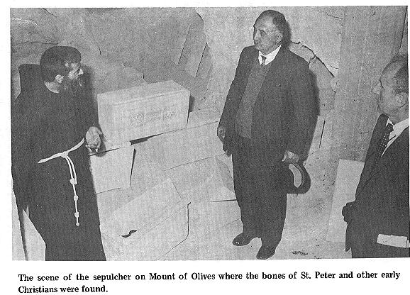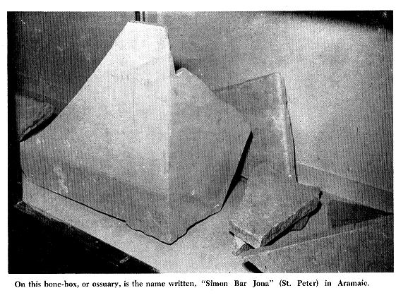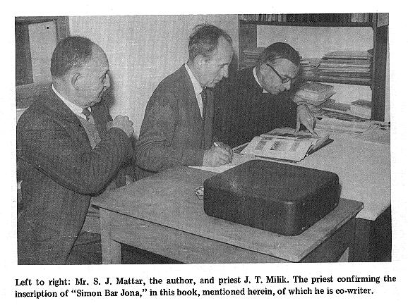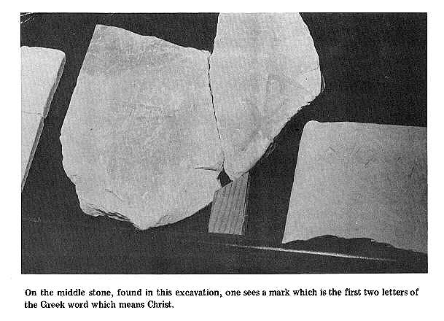ROMAN CATHOLICISM IS NOT BUILT ON THE ROCK
OF PETER BUT ON A GUESS THAT
PETER AUTHORISED ROME AS THE CENTRE OF THE CHURCH
From Peter’s Tomb Recently Discovered In Jerusalem by
F. PAUL PETERSON
http://biblelight.net
CONTEXT: Peter's bone box, ossuary, was found in Jerusalem in 1953 and the papacy asked that nothing be said about it and went about trying to make out Peter was buried in Rome. If Peter was not bishop of Rome or was never there then the papal pretence that the pope is the successor of Peter invested with power by Jesus as head of the Church is false.
Chapter 1
Saint Peter's Tomb
The Discovery of Peter's Tomb in Jerusalem 1953
All this explains why the Catholic Church has been so careful to keep this discovery unknown. They were successful in doing just that from 1953, when it was discovered by the Franciscans on their own convent site, until 1959. Having succeeded for so long in keeping "this thing quiet," as the Pope had admonished, they were off guard when a fellow at that time came along who appeared harmless but persistent. Little did they know that this fellow would publish the news everywhere. Their position in the world is shaky enough without this discovery becoming generally known.
As I have mentioned, I had a very agreeable talk with priest Milik, but I did not have the opportunity to see priest Bagatti while in Jerusalem. I wrote to him, however, on March 15, 1960, as follows: "I have spoken with a number of Franciscan priests and monks and they have told me about you and the book of which you are a co-writer. I had hoped to see you and to compliment you on such a great discovery, but time would not permit. Having heard so much about you and that you are an archaeologist (with the evidence in hand), I was convinced, with you, concerning the ancient burial ground that the remains found in the ossuary with the name on it, ‘Simon Bar Jona’, written in Aramaic, were those of St. Peter." It is remarkable that in his reply he did not contradict my statement, which he certainly would have done if he honestly could have done so. "I was very much convinced with you - ... that the remains found in the ossuary ... were those of St. Peter." This confirms the talk I had with the Franciscan monk in Bethlehem and the story he told me of Priest Bagatti’s going to the Pope with the evidence concerning the bones of St. Peter in Jerusalem. In his letter one can see that he is careful because of the Pope’s admonition to keep this discovery quiet. He therefore wrote me that he leaves the whole explanation of the Aramaic words, "Simon Bar Jona", to priest Milik. This is a familiar way of getting out of a similar situation. In priest Bagatti’s letter one can see that he is in a difficult position. He cannot go against what he had written in 1953, at the time of the discovery of this Christian-Jewish burial ground, nor what he had said to the Franciscan monk about his visit to the Pope. However, he does raise a question which helps him to get out of the situation without altogether contradicting himself and at the same time putting a smoke screen around the truth. He wrote,
"Supposing that it is ‘Jona’ (on the ossuary) as I believe, it may be some other relative of St. Peter, because names were passed on from family to family. To be able to propose the identification of it with St. Peter would go against a long tradition, which has its own value. Anyway, another volume will come soon that will demonstrate that the cemetery was Christian and of the first century to the second century A.D. The salute in God most devoted P. B. Bagatti C. F. M."
As I have shown, after the admonition of the Pope to "keep this thing quiet," priest Bagatti leaves the interpretation of the whole matter to priest Milik who offers several suggestions but in the end declares that the original statement of priest Bagatti may be true—that the inscription and the remains were of St. Peter. It is also very interesting and highly significant that priest Bagatti, in his attempt to neutralize his original statement and the consternation the discovery had and would have if it were generally known, says in reference to the name Simon Bar Jona (St. Peter), "It may be some other relative of St. Peter, because names were passed on from generation to generation." In other words he says that Peter’s name, Simon Bar Jona, could have been given him from a relative of the same name of generations before him, or, could belong to a relative generations after St. Peter. Both speculations are beyond the realm of the possible. First of all, it could not refer to a relative before St. Peter for the Christian burial ground could only have come into being after Jesus began. His public ministry and had converts; and therefore, could not belong to a relative before Peter’s time, since only those who were converted through Christ’s ministry were buried there. Titus destroyed Jerusalem in 70 A.D. and left it desolate. Therefore, it is impossible that the inscription could refer to a relative after Peter’s time. One encyclopedia explains the destruction in these words, ‘‘With this event the history of ancient Jerusalem came to a close, for it was left desolate and it’s inhabitants were scattered abroad." From all evidence, Peter was about fifty years old when Jesus called him to be an Apostle, and he died around the age of 82, or about the year 62 A.D. Since by these figures there was only eight years left from the time of Peter’s death until the destruction of Jerusalem, it was then impossible that the inscription and remains belonged to generations after Peter. In those days names were passed on to another only after a lapse of many years. But let us say that immediately after the death of St. Peter, a baby was christened, "Simon Bar Jona", the inscription still could not have been of this baby for the remains were of an adult and not of a child of eight years who had died just before the destruction of Jerusalem in 70 A.D., at which time "the history of ancient Jerusalem came to a close, for it was left desolate and its inhabitants were scattered abroad."
This ancient Christian burial ground shows that Peter died and was buried in Jerusalem, which is easily understandable since neither history nor the Bible tells of Peter’s having been in Rome. To make matters more clear, the Bible tells us that Peter was the Apostle to the Jews. It was Paul who was the Apostle to the Gentiles, and both history and the Bible tells of his being in Rome. No wonder that the Roman Catholic Bishop, Strossmayer, in his great speech against papal infallibility before the Pope and the Council of 1870 said, "Scaliger, one of the most learned men, has not hesitated to say that St. Peter’s episcopate and residence in Rome ought to be classed with ridiculous legends."
----
The secrecy surrounding this case is amazing, and yet understandable, since Catholics largely base their faith on the assumption that Peter was their first Pope and that he was martyred and buried there. But I am somewhat of the opinion that the Franciscan priests, those who are honest, would be glad to see the truth proclaimed, even if it displeased those who are over them. While visiting with priest Milik, I told him of the highly educated priest with whom I had spoken just before going from Rome to Jerusalem. He admitted to me that the remains of Peter are not in the tomb of St. Peter in the Vatican. I asked him what had happened to them? He responded, "We don’t know, but we think that the Saracens stole them away." First of all, the Saracens never got to Rome, but even if they had, what would they want with the bones of Peter? But they never got to Rome, so there it ends. We had a good laugh together, but more so when I told him of my discussion with a brilliant American priest in Rome. I asked this American priest if he knew that the bones of Peter were not in the "Tomb of St. Peter" in the Vatican. He admitted that they were not there. However, he said that a good friend of his, an archaeologist, had been excavating under St. Peter’s Basilica for the bones of St. Peter for a number of years and five years ago he found them. Now a man can be identified by his fingerprints, but never by his bones. So I asked him how he knew they were the bones of St. Peter? He hesitated and tried to change the subject, but on my insistence he finally explained that they had taken the bones to a chemist, and they were analyzed and it was judged that the bones were of a man who had died at about the age of sixty-five; therefore, they must be Peter’s. How ridiculous can people be?
Mark you, all the priests agree that the Vatican and St. Peter’s were built over a pagan cemetery. This was a very appropriate place for them to build since, as even Cardinal Newman admitted, there are many pagan practices in the Roman Catholic Church. You realize surely, that Christians would never bury their dead in a pagan cemetery, and you may be very sure that pagans would never allow a Christian to be buried in their cemetery. So, even if Peter died in Rome, which is out of the question, surely the pagan cemetery under St. Peter’s Basilica would be the last place in which he would have been buried. Also, Peter from every indication, lived to be over 80 and not 65 years old. The Pope was right, going back to the early Christian burial ground, they must make changes and many of them and fundamental ones at that. But I am afraid that the Pope’s (Pius XII) admittance of the discovery on Bagatti’s presentation of the documentary evidence was to satisfy Bagatti but at the same time admonishing him to keep the information quiet, hoping that the truth of the discovery would die out. But they have said that after all these years of excavation under the Vatican, they have discovered Greek words which read, "Peter is buried here," and it gives the date 160 A.D. First of all, the very structure of the sentence immediately gives one the impression that either quite recently or long ago, someone put the sign there hoping that it would be taken as authentic in order to establish that which then, and even now, has never been proven. Then there is a discrepancy in the date, for Peter was martyred around the year 62 A.D. and not 160 A.D. Thirdly, why is it that they mention nothing about finding bones under or around the sign? While visiting the Catacombs, one sees a few things which are not becoming to Christians, but which tend to indicate that the Christians had some pagan practices, similar to those of Rome today. Nothing is said about them and only after persistent questioning will the Roman Catholic priest, who acts as guide, tell you that those things, images, etc., were placed there centuries after the early Christian era.
In 1950, just a few years prior to the discovery of the Christian burial ground in Jerusalem, the Pope made the strange declaration that the bones of St. Peter were found under St. Peter’s in Rome. Strange it was, for since beginning to build the church in 1450 (finished in 1626) they erected, St. Peter’s Tomb (?) under the large dome and Bernini's serpentine columns. Since then multiplied millions were thereby deceived into believing that the remains of St. Peter were there, which the hierarchy had all along known was not true, as is proven by the late Pope’s declaration. The following was published in the Newsweek of July 1, 1957:
"It was in 1950 that Pope Pius XII in his Christmas message announced that the tomb of St. Peter had indeed been found, as tradition held, beneath the immense dome of the Cathedral (there was, however, no evidence that the bones uncovered there belonged to the body of the martyr)." The parentheses are Newsweek’s.
To make an announcement of such importance when there is absolutely "no evidence" is rather ridiculous as is also brought out in the Time Magazine of October 28, 1957 (as in above, we quote the article word for word).
"A thorough account in English of the discoveries beneath St. Peter’s is now available ... by British archaeologists Jocelyn Toynbee and John Ward Perkins. The authors were not members of the excavating team, but scholars Toynbee (a Roman Catholic) and Perkins (an Anglican) poured over the official Vatican reports painstakingly examined the diggings. Their careful independent conclusions fall short of the Pope’s flat statement." (The Pope’s statement that the remains of St. Peter were found under St. Peter’s in Rome). The excavation under St. Peter’s for the remains of St. Peter is still going on secretly, in spite of the Pope’s declaration of 1950.
Then in 1965, an archaeologist at Rome University, Prof. Margherita Guarducci, tells of a new set of bones belonging to Peter. The story was fantastic but lacked common sense and even bordered on the infantile—but a drowning man will grab for a straw and a straw it was to many. But the Palo Alto Times (California), May 9, 1967, came out with an article on the subject, and I quote, "Other experts, among them Msgr. Joseph Ruysschaert, vice prefect of the Vatican Library are not convinced by Miss Guarducci’s evidence. ‘There are too many unknowns,’ he told reporters on a recent tour of the Vatican grottoes, ‘There is no continuous tracing of the bones. We lack historical proof. They could be anyone’s bones.’ The Vatican would seem to be on the monsignor's side because so far it has taken no steps to officially recognize the bones as St. Peter’s," continues the article.
The intelligent priest of whom I have mentioned said that Peter’s bones were found and he was a man who died of about 62 years of age, the tests indicated. Pope Pius XII declared these bones were the bones of St. Peter, in his Christmas message of 1950. These were the same as claimed by Newsweek, "there was, however, no evidence that the bones uncovered there belonged to the body of the martyr (Peter)," as well as the above doubtful statements of the archaeologists working on the case. The Pope, notwithstanding, was overjoyed to think they had found the bones of St. Peter until further examination proved that these bones were those of a woman. This fact came out in an article on the subject in the S. F. Chronicle of June 27, 1968.
To continue the history of another case in which they have erred: In spite of the statements by the high Papal authority above and the resultant lesson that should have been learned, the Pope, a year later claimed the Prof. Margherita bones as his very own, that is, those of St. Peter. When the bones were found there was little importance placed upon them and they were filed away as such. But when the first set of Peter’s bones turned out so tragically, there was a vacuum left and something had to be done. Again they turned their thoughts to the filed-away bones, the only hope they had of success. In them there was a ray of hopes for the bones were minus a skull, which could go along with the story of the supposed skull of St. Peter which had for centuries been guarded in the church of St. John Lateran in Rome. With a generous mixture of ideas, suppositions, theories and wishful thinking, a fairly logical story emerged. It was then declared by Pope Paul as the Gospel truth, that these now, were the genuine bones of St. Peter, and most of the faithful accepted them as such. For a while all was well until another hitch developed. This time, as fate would have it, the bones in connection with the skull which was guarded for centuries as that of St. Peter, were found incompatible to the more recent bones of St. Peter. The dilemma was terrible. They were between the Devil and the deep blue sea. They have juggled around the skulls of St. Peter causing confusion. It was a choice of claiming these bones championed by Prof. Margherita as fake, or claiming as fake the skull accepted by hundreds of Popes as that of St. Peter. They rejected the past rather than expose themselves to the ridicule of the present. Prof. Margherita claims in this article which appeared in the Manchester Guardian in London, as well as the S. F. Chronicle of June 27, 1968, concerning the long accepted skull of St. Peter, as "it is a fake." Then the article continues, "The hundreds of Popes and millions of Roman Catholics who have accepted and venerated the other skull were innocent victims of another early tradition."
But the most astounding statement in the long article found in the above mentioned newspapers is, "The professor did not submit them (Peter’s bones?) to modern scientific tests, which would have determined the approximate age, because, she feared, the process would have reduced them to dust." How could any scientific study of bones be carried out without first scientifically determining the age of the person, or bones? This would be of the greatest interest and the most important for further research. Also any scientist or chemist knows that you do not have to submit the whole skeleton for testing to determine the age. A part of the shin bone or of a rib would be sufficient. It appears that she was protecting her "Peter’s bones" from another possible disaster, which a wrong age would have caused. The Vatican and others have calculated through all existing evidence that Peter lived to be around 80 and 82 years, and that he died around the years of 62 or 64 A.D. These figures go along perfectly, as does everything else in the case, with the remains found in the Christian burial ground on the Mount of Olives and in the ossuary on which was "clearly and beautifully written," Simon Bar Jona in Aramaic. ---
Copyright 1960 by F. PAUL PETERSON (4th Edition, 1971). Copies may be obtained from your local bookstore or from the author and publisher, F. Paul Peterson, P.0. Box 7351, Fort Wayne, Indiana, Price $2.00. Permission is granted to reproduce any part of this book if title, price and address where it may be purchased are given.









